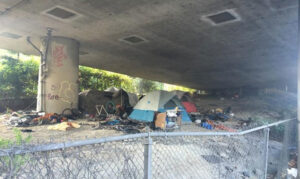Homeless camps are a real pain, there’s no denying it.
Neighbors very legitimately want the campers to leave and the sites cleaned up. More often than not, unsponsored encampments are very bad neighbors. The campers litter, start fires, do drugs, steal, and sometimes commit violent crimes.
But Seattle TV station KOMO 4 News’ reporting on the issue is suspect. Ever since the station was acquired by the rightwing Sinclair Broadcasting Group, it’s been on an anti-homeless crusade. Its documentary Seattle Is Dying was criticized by homeless advocates and Seattle’s city prosecutor as misleading (details here).
A KOMO story on Friday, February 10, 2023, describes neighbors’ frustrations with a homeless camp under the I-5 bridge a block away from a Seattle elementary school, then reports that, “Four public agencies are coordinating to deal with the encampment: the KCRHA, the city of Seattle, the Washington Department of Transportation (WSDOT) and the Washington State Patrol (WSP).” KCRHA is the King County Regional Housing Authority.
What this tells you is state, county, and city authorities aren’t ignoring the problem. But the neighbors don’t like the way they’re dealing with it. They simply want the encampment gone. They don’t want to hear government officials say it’s not that simple or easy.
KOMO reported, “WSDOT regional administrator Brian Nielsen said the agencies are conducting a public safety assessment and doing daily outreach to people at the camp to connect them with housing resources. Nielsen, however, shot down the idea of doing a ‘sweep’ of the camp.”
Nielsen added, “I must reiterate that our agencies cannot do that. As a property owner, WSDOT knows from experience that clearing the site without providing real options for services and housing will not solve your safety concerns. A sweep will simply move those safety concerns around the neighborhood.”
KOMO said, “Nielsen added the state funding for the Right of Way Safety Initiative requires agencies to transition people living in the right of way to ‘safer housing opportunities, with an emphasis on permanent housing solutions.'”
But both the state governor and city attorney oppose allowing campers to remain on WSDOT right-of-way. And for the neighbors, merely cleaning up the camp isn’t enough; they want the campers removed.
KOMO reported, “Parents … say there’s nothing left to assess and the state’s focus on finding housing for the people at the encampment does not deal with the immediate safety concerns.” One neighbor said, “We have a housing crisis, we have a mental health crisis. There’s a drug crisis and it’s all wrapped together. I don’t think cleaning it does enough to stop the crime, or address the crime here.”
I totally sympathize with the neighbors. But here’s the problem. KCRHA says shelter beds are available, but points out that homeless people can’t be forced to take them. Some homeless people accept housing and social services; but many want to stay on the streets, where they’re free to do drugs and don’t have to follow rules. And, as WSDOT learned, pushing them out of one encampment just sends them somewhere else.
This scenario is playing out in cities across America. The homeless problem does feel intractable, and ties in with the nationwide drug problem, which certainly seems intractable unless policing efforts cut off the flow of drugs to the streets. But law enforcement hasn’t been able to do that.
In America you can’t remove mentally ill people from the streets and put them in mental institutions without a court order based on a finding of incompetency or danger to self or others. You can’t jail people for being homeless, or for minor offenses like trespassing and littering. Our society has moved away from jailing people for simple drug possession and use.
When violent crimes occur, such as robbery or murder, you can remove those perpetrators from the street population and incarcerate them. But most of the homeless campers aren’t prosecutable for serious crimes, so that doesn’t solve the homeless camping problem.
If there was an easy solution, someone would’ve figured it out by now. People thinking about the problem have concluded there is no “silver bullet” solution, and the homeless problem can only be managed. I don’t know the answer, and I’m guessing there isn’t one, beyond doing what’s being done. I know you can’t expect homeless people to disappear. As long as they exist, they have to be somewhere.
KOMO’s reporting is useful to extent it’s objective and informs the public. But looking past their slant on the homeless issue, it’s clear they haven’t come up with an answer for the problem, either.
Below: Undated photo of the homeless camp under the I-5 bridge at NE 45th Street in Seattle
